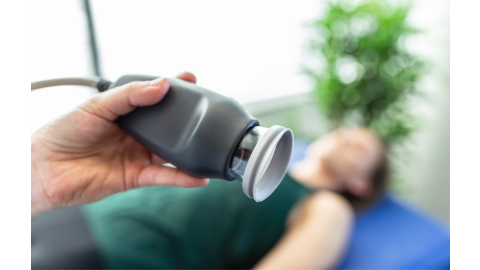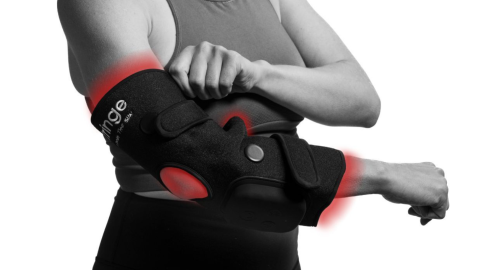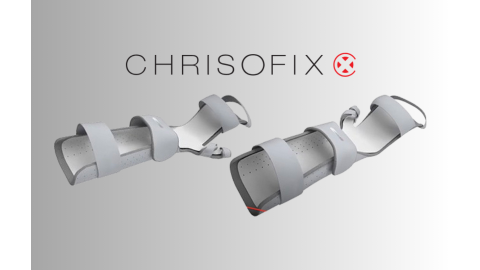Key Takeaways
- Resistance training is a form of exercise which causes the muscles to contract and helps build strength and endurance
- Studies show that resistance training can help build muscle power which can be used to counter external forces and help handicapped individuals increase strength, balance, and well-being
- The exercises in this article are specifically suited for wheelchair users and are customizable to the individual
Top Products in This Article
Exercise is an important aspect of everyday life that improves health and decreases the risk of developing many diseases. Resistance training provides several benefits including weight management as well as increased flexibility and strength. This form of exercise also helps improve balance, which is crucial for wheelchair users. An increase in muscle tone helps to protect the joints and reduces the risk of osteoporosis. Many individuals find that strength training improves their overall quality of life.2
National Mobility Awareness Month is observed during the month of May. During this month, we encourage individuals with disabilities to continue living life while moving forward by discovering new mobility solutions. In this article, we discuss a variety of seated resistance exercises so you can find a regime to match both your mobility and fitness level. Let’s get active!
Table of Contents
- The Importance of Exercise for Wheelchair Users
- Seated Upper Body Training
- Seated Arm Training
- Seated Leg Training
- Conclusion
The Importance of Exercise for Wheelchair Users
As a result of sitting for extended periods of time, wheelchair users typically have a high BMI, percentage of body fat, as well as serum lipid, cholesterol, and blood glucose concentrations. Studies have shown that regular exercise improves both poor cardiometabolic risk profiles and cardiorespiratory health among disabled individuals.1
Exercise is also proven to help control weight, improve mental health and overall mood, decrease the risk of cardiovascular diseases, and control insulin and blood sugar levels. Resistance training helps wheelchair users build muscle and decrease their chances of falling. The exercises below provide a challenging yet rewarding workout for wheelchair-bound individuals.
Seated Upper Body Training

Seated upper body training is an excellent way to target all the major muscles in the upper body including the chest, back, shoulders, arms, and core while also increasing endurance. Consult your doctor before trying any new form of exercise.
Resistance bands are a great addition to a seated upper body workout, as they come in a variety of tension levels and can be used anywhere. This means there’s an option that fits any fitness level. Below we have listed 4 types of resistance band seated upper body exercises that you can try!
First, pick a resistance band that works for you. Choose between a beginner or an advanced kit. If you’re looking for a resistance band with loops to enhance your workout, TheraBand CLX- Resistance Band with Loops might be the best option. Then start your workout!
1. Seated Upper Body Exercise

Follow along with this instructional video or follow the directions below.
Begin with a long (2.5 meter) band wrapped on each hand with palm open. Perform the following movements against the resistance of the band with both hands:
- Thumb and finger abduction and extension- To abduct the thumb and fingers, move the fingers away from the hand. To extend, move the thumb away from the other fingers
- Wrist Extension- Extend your arm out in front of you and bring the back of the hand toward your body
- Forearm Supination- Place your arms out in front of you with your palms facing down. Rotate the hands away from the midline of the body until your palms face the ceiling
- Shoulder external rotation and Elbow Extension- Bend the arm at 90 degrees while pulling the band away from the midline of the body. Hold the band in each hand and place your elbows at your side. Extend straight back from the elbow to activate the triceps
- Shoulder Abduction and Extension- Once the triceps are activated, slowly extend the elbows to a straight arm position while keeping the palms facing the ceiling. This allows for shoulder abduction and extension. Scapular retraction- Move the shoulder blades toward the spine. Maintain the contraction for 2-3 seconds. Repeat
- Slowly return in exactly the reverse order. Repeat 2 to 3 times. Maintain an upright posture with neutral neck and back
2. Seated Shoulder & Upper Back Strength Training Exercises

Take a shoulder width grip of the resistance band and slowly open and close it in front of you
Exercise #1 - Place the band firmly underneath each heel, while pulling your shoulders back and squeezing the band one arm at a time
Exercise #2 - Place the band firmly underneath each heel while pulling your shoulders back and squeezing the band using both arms
Exercise #3 - Lift the arms wider than the shoulders and bring the band in front of the chest, slowly raising it above the head
Exercise #4 - Hold the resistance band at a diagonal, with one hand above the other. Slowly pull and release the band
Repeat on the other side
3. Seated Core Exercises
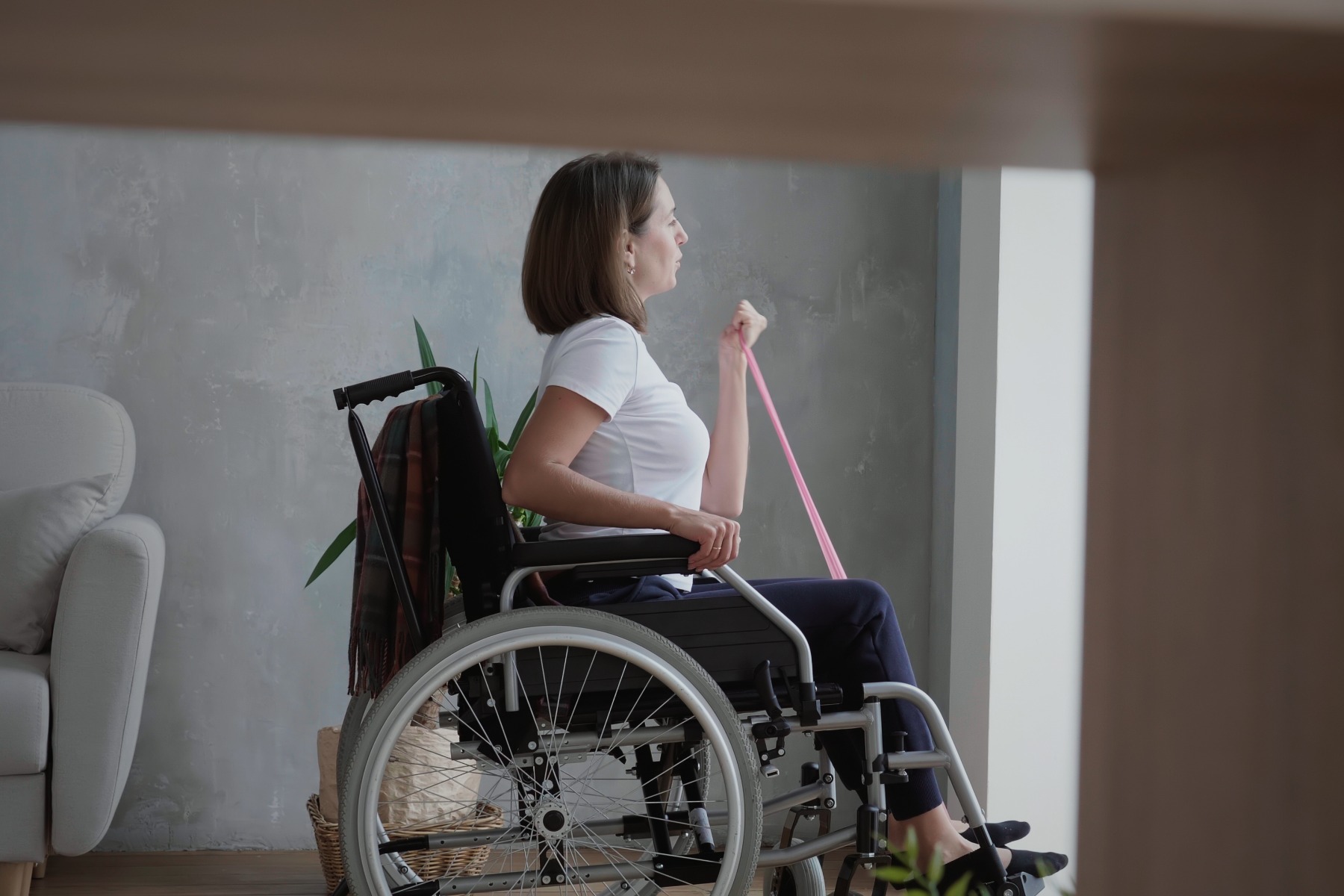
Exercise #1 - While seated, place one loop of the resistance band around your foot and bring your arm out to the side. Slowly raise and lower the arm
Switch to the other side
Exercise #2 - Take a shoulder width grip of the resistance band, while pulling it apart and rotating from side to side (8-10 reps)
Exercise #3 - Place the resistance band underneath both feet. Grab one loop of the band, while keeping your arms straight, slowly bending to the opposite side
Repeat on the other side
Exercise #4 - Take a shoulder width grip of the resistance band, while pushing each leg up and out (8-10 reps per leg)
4. Seated Chest Exercise
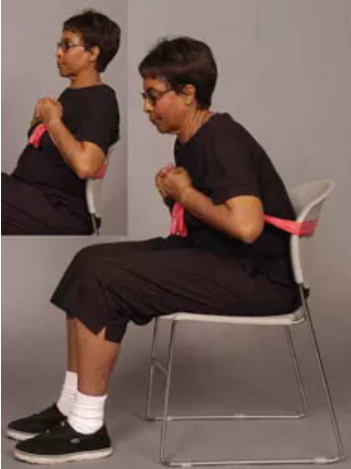
- Select two bands of your desired resistance
- Loop the two bands around the back of your wheelchair
- Lean forward with the bands at your chest
- Slowly sit up while pulling the bands
- Return to the starting position and repeat (5-7 reps)
To perfect your technique and learn additional seated upper body resistance exercises, check out this instructional video!
Several other products are available to help with resistance training. TheraBand Ankle and Wrist Weight Sets are perfect for home exercise programs. The set allows users to increase weight in strength training and rehabilitation programs without changing technique, which is fundamental to the principles of progressive exercise.
The TheraBand FlexBar is made for stretching the upper extremities to help reduce muscle soreness and joint pain. The TheraBand Flexbar can also be used for forearm and wrist strengthening exercises. TheraBand Hand Xtrainers is another great hand therapy tool for the forearm, wrist, hand, and fingers. Whether you are strength training or recovering from a surgery or injury, the Xtrainer is the perfect tool for rehabilitation, physical therapy, and conditioning. Both forms of exercise equipment are ideal for wheelchair users.
Additional Exercise Tools for Wheelchair Users
Seated Arm Training
Whether you are working out from the office or at home, seated arm workouts provide several benefits. They allow for low impact training which can easily be incorporated into your daily schedule. Most individuals can burn several hundred calories when adding a resistance band to this form of exercise.
Products you can add to your seated arm workout routine:
5. Elbow Flexion
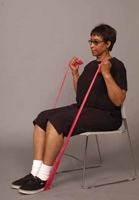
- While seated, place the middle of the band around both feet and grasp each end of the band with palms facing forward
- Keep your elbows at your side
- Keeping wrists straight, bend the elbow, bringing your hands to shoulders
- Slowly return to the starting position and repeat
6. Elbow Extension

- While seated, hold one end of the band in the opposite hand with your elbow straight to stabilize it
- Grasp the band with the other hand and your elbow bent
- Keep the elbow behind your side and straighten your arm, pulling the band backward
- Hold steady with opposite hand and slowly return to starting position, repeat
- Repeat on the other arm
7. Elbow/Bicep Curl

- Sit on a chair while holding your feet out wide
- Place one end or loop of the resistance band under your foot. Place the other end in your opposite hand. Rest your hand on your thigh
- Start at a 90-degree angle or more, with the band bent
- Slowly do a bicep curl by pulling your hand with the band toward your shoulder
- Perform 8-10 reps, then switch to the other side
8. Overhead Press

- While seated, place the center of the band securely under one foot, and grasp each end of the band with palms facing forward
- Lift your arms forward and upward, extending your elbows with palms facing forward
- Slowly return to your starting position and repeat
Unsure about which resistance band to try? Learn more about which TheraBand is right for you as well as additional FAQ in this article.
Seated Leg Training
Leg training is essential in order to promote engagement of the major muscle groups of the body. This form of exercise is especially important for wheelchair users who do not use their legs to walk. Strong leg muscles help to improve overall performance, as well as prevent injury and chronic health problems. Never skip a leg day with these seated leg exercises!
Products you can add to your seated leg workout routine:
Leg Training Exercises
*Please note that these exercises are not for wheelchair users with spinal cord injuries or paralysis of the lower body.
9. Knee Curl
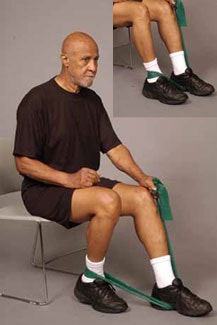
- Sit on the edge of a sturdy chair
- Begin by looping the center of the band around the ankle of your exercising leg
- Bring the ends of the band underneath the foot of the opposite leg to stabilize and grasp the ends by your knee
- Slowly bend your knee against the band, pulling backward
- Hold and slowly return, then repeat
- Switch legs and repeat
10. Leg Press

- While seated, begin by wrapping the middle of the band under your foot
- Grasp the ends of the band at your chest, taking up the slack while you bend your hip and knee
- Press your foot downward into the band, extending your hip and knee
- Hold and slowly return, then repeat
- Repeat on the opposite leg
11. Hip Flexion

- Sit in a sturdy chair
- Begin by looping the center of the band around the top of the knee of your exercising leg
- Bring the ends of the band underneath the foot of the opposite leg to stabilize and grasp the ends by your knee
- Slowly flex your hip against the band, pulling upward. Hold and slowly return
- Keep your back straight; don't lean forward
12. Knee Extension

- Sit on the edge of a sturdy chair with feet together
- Begin by looping the center of the band around the ankle of your exercising leg
- Bring the ends of the band underneath the foot of the opposite leg to stabilize and grasp the ends by your knee
- Slowly extend your leg so your knee is straight against the band
- Hold 1 to 2 seconds and slowly return
Conclusion
The upper body, arm, and leg resistance band exercises in this article are great ways to help with strength training and muscular rehabilitation. With consistent use, resistance bands enhance both performance and overall strength. These exercises can also improve overall well-being and mood.
Another option to achieve an even better full body workout is to use therapy resistance putty. Therapy Putty is a pliable therapy tool that can be used for a wide variety of strengthening exercises designed to improve range of motion and flexibility. The putty can be stretched, pinched, pulled, squeezed, and rolled to target specific muscles and joints such as the wrists, forearms, and hands.
Incorporate resistance putty into your workout routine today to practice a variety of strengthening exercises designed to improve range of motion and flexibility!
You can even combine TheraBand Resistance Bands and resistance putty for a full workout. Check out this informative article that discusses the multiple uses of therapy putty as well as some additional exercises that you can try!
Start your workout today!
References
Ellapen, T. J., Hammill, H. V., Swanepoel, M., & Strydom, G. L. (2017). The health benefits and constraints of exercise therapy for wheelchair users: A clinical commentary. African Journal of Disability, 6. doi:10.4102/ajod. v6i0.337. Retrieved from https://bit.ly/3xxWYag
Mayo Clinic Staff. (2021, May 15). Strength training: Get stronger, leaner, healthier. Retrieved from https://mayocl.in/3qgDjcQ
Resistance Training Exercises for Disabled People. (2018, May 28). Retrieved from https://bit.ly/3wKfEDV
Medical Disclaimer: The information provided on this site, including text, graphics, images and other material, are for informational purposes only and are not intended to substitute for professional medical advice, diagnosis or treatment. Always seek the advice of your physician or other healthcare professional with any questions or concerns you may have regarding your condition.








 France
France Australia
Australia






















